George Washington Announces Provost Selection
Steven Lerman will serve as second-in-command to President Knapp in new role.
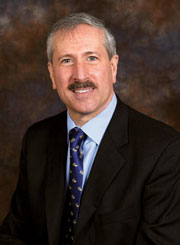
Steven Lerman joins GW as provost and executive vice president for academic affairs. He comes from the Massachusetts Institute of Technology, where he currently serves as vice chancellor and dean for graduate education.
Jessica McConnell
George Washington University President Steven Knapp announced March 3 the selection of Steven Lerman as provost and executive vice president for academic affairs and as the A. James Clark Professor of Civil and Environmental Engineering, effective July 1.
Dr. Lerman will join GW from the Massachusetts Institute of Technology, where he currently serves as vice chancellor and dean for graduate education, acting as the chancellor’s chief deputy and working to develop strategic initiatives across the Office of the Dean of Graduate Education, Office of the Dean for Undergraduate Education, and the Division for Student Life.
“Dr. Lerman understands George Washington’s aspirations, its unique position in Washington and the world, and its extraordinary opportunities,” President Knapp says. “He has a strong record of engaging students and working collaboratively and effectively with colleagues; those skills will help us build an ever stronger faculty, raise the university’s stature, and continue to enhance the academic experience of our students.”
Dr. Lerman has more than 40 years of experience as a leader and scholar at one of the nation’s most prestigious research universities. He began at MIT as a student, earning a Bachelor of Science in Civil Engineering. He also earned a Master of Science in Civil Engineering and a PhD in Transportation Systems Analysis. He joined the faculty in 1975 as assistant professor of civil engineering and rose through the ranks, serving as chair of the faculty twice: as dean of graduate education since 2007 and as vice chancellor since 2008.
Dr. Lerman’s awards and honors have included the Advisor of the Year Award from the National Association of Graduate and Professional Students, the Maseeh Teaching Award for Best Departmental Teacher, and the Class of 1922 Distinguished Professorship.
“I am honored that The George Washington University has selected me to serve as its provost. The opportunity to work as a member of President Knapp’s team to enhance the university’s well-deserved reputation for academic excellence and service is truly extraordinary,” Dr. Lerman says.
President Knapp also announced that for the first time GW’s top two leaders
will live on George Washington campuses. Dr. Lerman and his wife, Lori, will live on the Mount Vernon Campus.
The search was initiated following the announcement of the retirement of Executive Vice President for Academic Affairs Donald R. Lehman, PhD ’70, who has served the university for 38 years. Dr. Lehman will continue to serve as the university’s chief academic officer until June 30 and then will act as senior adviser to President Knapp until Dec. 31.
As part of a reorganization, Dr. Lerman will serve as the chief academic officer for George Washington’s nine colleges and will oversee all programs and offices associated with student life on campus. This change will bring GW in line with practice at most universities today, where the role of provost, who acts as second-in-command and serves as president in the president’s absence, is held by the chief academic officer. This management change establishes a
single point of accountability, immediately below the president, for all academic and student-related programs.
President Knapp was deeply involved in the recruitment of the new provost, personally interviewing each of the 22 candidates considered in the rigorous, nationwide search. As part of the search process, candidates were brought to campus to meet with various groups, including student groups.
Professor of Political Science Forrest Maltzman led the search committee, which was composed of faculty members elected by their respective schools. Other committee members included Lydia Thomas, GW Board of Trustees; Beth Nolan, GW senior vice president and general counsel; David Dolling, dean of the School of Engineering and Applied Science; Michael Brown, dean of the Elliott School of International Affairs; Lilien Robinson, professor and chair of the Faculty Senate Executive Committee; and Jack Siggins, university librarian.
"We were looking for someone who has a first-rate scholarly reputation and who has the understanding, creativity, energy, and diplomatic skills to be a transformative leader, and Steven Lerman is clearly such a person,” Dr. Maltzman says.
GW Names New Vice President of Development and Alumni Relations
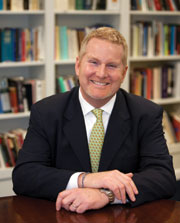
GW Vice President for Development and Alumni Relations Michael Morsberger, most recently from Duke University, spent nine years at Johns Hopkins Medicine in Baltimore.
Jessica McConnell
Michael Morsberger, who comes most recently from Duke University, looks forward to building philanthropic partnerships at George Washington.
George Washington University President Steven Knapp announced Feb. 17 the selection of Mr. Morsberger as the university’s vice president for development and alumni relations. He will lead GW’s fundraising and alumni relations teams and will set goals and priorities for fundraising. Mr. Morsberger most recently served as vice president for Duke Medicine development and alumni affairs and has more than 23 years of leadership experience in the industry.
“Mike Morsberger brings to this position a breadth of experience from top-tier institutions,” Dr. Knapp says. “I look forward to working with him to raise the resources George Washington needs to achieve our aspirations.”
While at Duke Medicine, Mr. Morsberger led fundraising and alumni relations activities for Duke University Health System and the academic and research efforts associated with the medical and nursing schools. Previously, he served as associate vice president of development and executive director at the University of Virginia, where he was instrumental in planning the health system’s $500 million campaign and served as a senior member of the university’s development team in launching the largest fundraising endeavor ($3 billion) at a public university in the United States.
Prior to his work at the University of Virginia, he spent nine years at Johns Hopkins Medicine in Baltimore, where he oversaw advancement for the Sidney Kimmel Comprehensive Cancer Center. Mr. Morsberger was involved in the largest single gift in Johns Hopkins’ history, when philanthropist Sidney Kimmel committed $150 million to name the center in 2001.
“I am honored to be joining George Washington University at this very pivotal time,” Mr. Morsberger says. “I look forward to joining Dr. Knapp, the Board of Trustees, the university’s senior leadership team and deans, and working with the development and alumni relations team. Meaningful alumni engagement and true philanthropic partnership will be hallmarks of the program we are building here at GW.”
Mr. Morsberger holds a bachelor’s in journalism from Radford University and a master’s in philanthropy and development from St. Mary’s University of Minnesota. In addition to his work at the University of Virginia and Johns Hopkins, he has worked in development at Mount Washington Pediatric Hospital Foundation, Calvert Hall College Preparatory School, and the National Aquarium in Baltimore.
In his free time, Mr. Morsberger enjoys playing golf, taking long walks with his dogs, and attending his two daughters’ lacrosse games.
Advancing on Autism
George Washington’s plans to advance research and scientific discovery in autism—one of several key areas identified last fall—have begun to come together in the form of a new research center.
Plans for the GW Autism Research, Treatment and Policy Institute took a step forward in early March, with university officials and faculty members presenting their blueprint to a team of outside experts on autism, who will help plot the path ahead.
The group comprised three scientists from
the University of Southern California’s Keck School of Medicine, the University of Miami’s Miller School of Medicine, and the nonprofit research-funding and advocacy group Autism Speaks.
The autism institute would be a partnership with the Center for Autism Spectrum Disorders at Children’s National Medical Center, according to GW Vice President for Research Leo Chalupa.
The institute’s scientists and physicians would strive to bolster the knowledge and treatment of autism from several angles, including providing assessments and treatments (like medication or therapy to sharpen social skills), conducting research and clinical trials, and becoming a hub of public policy analysis on the topic.
The general term “autism” refers to a group of neurodevelopmental disorders that fall along a spectrum. Autism spectrum disorders often are typified by impairments with communication and social interactions; they are estimated to affect perhaps as many as 1 in 100 children and adults, most commonly males.
Dr. Valerie Hu, who led the faculty planning committee, says that more than 30 faculty members across the university are working on autism research or research in related fields. “If we pull our expertise together, we can bring to the table new perspectives that are really going to aid research and push it forward,” she says.
Autism-related efforts at GW currently range from explorations of the brain and its development to studying the use of art therapy for autistic patients; from training teachers to analyzing health care policy and research methodology; from studying the effect of culture in identifying and treating autism to Dr. Hu’s search for biological hallmarks that could be used to diagnose the disorder.
Last October President Steven Knapp announced a plan to double the university’s investment in learning and research for the next five years—amounting to an extra infusion of $60 million each year. This new direction, he said at the time, seeks to match “the excellence of our instruction with the strength of our research.”
Six initial areas of focus were identified based on the input of faculty and deans: autism, computational biology, science policy, sustainability, neglected diseases, and energy. In the meantime, four more topics have been added: the global status of women, the arts, cancer, and global security.
Plans for some of these areas are developing swiftly, particularly neglected diseases. In February, the National Institutes of Health awarded the university a $15 million grant to establish the Research Center for the Neglected Diseases of Poverty, to be housed in the GW Medical Center’s Ross Hall.
—Danny Freedman
Researcher Discovers Dinosaur Species
A George Washington University expedition to the Gobi Desert of China has enabled researchers to solve the puzzle of how one group of dinosaurs came to look like birds independent of birds. The discovery extends the fossil record of the family Alvarezsauridae—a bizarre group of bird-like dinosaurs with a large claw on the hand and very short, powerful arms—back 63 million years, further distancing the group from birds on the evolutionary tree. Until now, there was no direct evidence that dinosaurs of this type lived during the Late Jurassic, approximately 160 million years ago. George Washington University doctoral candidate Jonah Choiniere named the newly discovered species of dinosaur, “Haplocheirus sollers” (meaning simple, skillful hand). Mr. Choiniere’s research is featured in the Jan. 29 issue of the journal Science.
“Haplocheirus is a transitional fossil, because it shows an early evolutionary step in how the bizarre hands of later alvarezsaurs evolved from earlier predatory dinosaurs,” Mr. Choiniere says. “The fossil also confirms our predictions that Alvarezsauridae should have been evolving in the Late Jurassic time period.”
The fossil of the new species contains several distinguishing features that link it to Alvarezsauridae, the family of dinosaurs that includes species such as Mononykus (meaning one claw) and that was previously thought to be a flightless offshoot of ancient birds because of skeletal similarities. Despite the similarity between the skeletons, Mr. Choiniere’s research demonstrates that the family Alvarezsauridae evolved in parallel to birds and did not descend from them. The new species shows some of the earliest evolutionary stages in the development of a short, powerful arm with a single functional claw that may have been used for digging termites.
The Late Jurassic is an important period for bird evolution as evidence suggests that birds first evolved from theropod, or bird-footed, dinosaurs at that time. Paradoxically, fossils of dinosaurs closely related to birds from this time are extremely rare.
The 10-foot-long, nearly complete skeleton of Haplocheirus sollers was found preserved in river-lain rock in the Xinjiang Autonomous Region of northwestern China, a region well-known for its Late Jurassic fossils. It was collected in 2004 during a series of expeditions to Xinjiang co-led by Dr. James Clark of GW and Dr. Xu Xing of the Chinese Academy of Sciences’ Institute of Vertebrate Paleontology and Paleoanthropology, co-authors on the report. These expeditions were extremely successful, resulting in the discovery of a small, agile relative of crocodilians (Junggarsuchus sloani); the oldest horned dinosaur (Yinlong downsi); one of the oldest tyrannosaurs (Guanlong wucaii); and several skeletons of an unusual, toothless new ceratosaurian dinosaur (Limusaurus inextricabilis) that were buried while stuck in mud pits. These discoveries were described in a TV documentary by National Geographic (“Dino Death Trap”) and a June 2009 article in National Geographic Magazine.
“The primary goal of our expeditions was to find evidence of the theropod dinosaurs closest to birds, and the discovery of Haplocheirus is one of our major discoveries,” Dr. Clark says. “This spectacular skeleton shows how the strange arms of Mononykus and other alvarezsaurs evolved from a more typically theropod grasping hand.”
Theropod dinosaurs include charismatic meat-eaters like Tyrannosaurus rex but also modern birds. Alvarezsaurs are one of several groups of theropods closely related to birds, including well-known species like Velociraptor.
The research was funded by the National Science Foundation Division
of Earth Sciences, the National Geographic Society, the Chinese National Science Foundation, and The George Washing
ton University.
Mr. Choiniere is a student of Dr. Clark,
the Ronald B. Weintraub Professor of Biology
in The George Washington University’s Columbian College of Arts and Sciences, and first accompanied Dr. Clark on his excavations in China in 2005. Mr. Choiniere’s article is titled “A Basal Alvarezsauroid Theropod from the Early Late Jurassic of Xinjiang, China.”
Business School Climbs in Rankings
The GW School of Business made significant strides in a pair of rankings released early this year, marking climbs for both the undergraduate and graduate programs.
The undergraduate program rose 14 spots to land at No. 51 nationwide in rankings by BusinessWeek magazine in March among a pool of 111 schools. The school also weighed in at No. 23 in a measure of academic quality.
In January, rankings by the Financial Times listed GWSB fifth worldwide among top schools for international business, two notches above last year’s report.
Among full-time Master of Business Administration programs in the Financial Times rankings, GW’s Global MBA leaped to No. 30 in the United States, up from No. 48 in 2009. Worldwide the program surged more than two dozen spots to No. 57, up from No. 85.
That survey also showed a dramatic improvement in the school’s research ranking, which rose to No. 60, up from No. 82 last year.
“These are great jumps,” says Murat Tarimcilar, associate dean for graduate programs at the business school, “and we really think this is only the beginning of it.”
In part, he says, that’s because the three years’ worth of data submitted for the rankings included only the inaugural year of the reformulated Global MBA program, which is now in its second year. The new curriculum weaves through each course an emphasis on business ethics, social responsibility and leadership, and a sharpened focus on the global marketplace.
The program has a mandatory work-abroad component, in which students consult for foreign businesses on very real problems—and so far they’ve been turning some heads. The work of one group of students was so well received in Turkey, for example, that the students were offered jobs on the spot.
Energy Institute Sparks Innovation
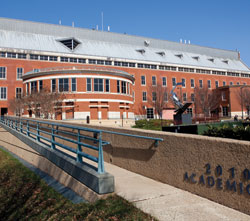
The new GW Energy Institute is located at the university’s Virginia Science and Technology Campus in Ashburn.
William Atkins
As the United States aims for energy independence, it needs new technology and better scientific understanding to move forward. Forging ahead is the new GW Energy Institute, headquartered at the Virginia Science and Technology Campus. The institute began powering up in fall 2008 and will be formally chartered sometime this year.
The university determined that energy was an emerging area that “fits our strategic plans and President Steven Knapp’s emphasis on sustainability,” says Craig Linebaugh, chief academic operating officer for the Virginia campus. “We want to make a contribution to solving the challenges of finding more efficient ways to use the fuels we use today; finding new types of renewable fuels, whether it’s solar or wind or other; and finding new ways of creating energy.”
The Energy Institute combines faculty members from the School of Engineering and Applied Science and the Columbian College of Arts and Sciences to bring together various engineering disciplines and sciences, such as chemistry and physics, to work on research ranging from building better batteries, to creating nanomaterials for high efficiency vehicles, and developing the next generation of wind energy technology.
To get the ball rolling last year, the university brought in expert faculty members in select areas. Stuart Licht, a renewable energy chemist, was first on board. Second was Stephen Hsu in the Mechanical and Aerospace Engineering Department, working in energy efficiency, nanomaterials, and energy technologies. The faculty also includes mechanical engineer Adam Wickenheiser, who works on aero-elastic materials, and Jack Tossell, a chemist who works with carbon sequestration, plus more than a dozen other faculty members working on energy research.
Current research ranges from renewable energy to energy efficiency. Dr. Licht is working on a battery solution. Current lithium ion batteries can only hold about one-fifth the energy of gasoline, so for an electric car to travel the same distance as an internal combustion-powered car, it would require a battery five times the size of a gas tank, Dr. Licht explains. So the electrochemist is looking for ways to store multiple electrons on a single molecule, instead of just one, like existing lithium ion batteries do.
Dr. Hsu’s work focuses on energy efficiency and renewal energy generation. In the energy efficiency arena, he investigates interface technology to reduce friction to increase fuel economy, net-zero energy houses/buildings, and geothermal-assisted heat pumps to boost energy efficiency in transportation and housing. In the area of renewable energy generation, he focuses on wind and solar energy generation, using innovations from materials to make the energy generation lower cost, yet higher performance. “In order to reduce energy consumption, you have to conserve and generate at the same time,” Dr. Hsu says.
Partnerships with corporations will be vital to the new institute, which will work with a large number of companies to help them manage their energy consumption.
“It’s one thing to do the basic science and make discoveries, but we want to then take the discoveries and translate them to practical use, where they become the batteries and the automobile that you buy,” Dr. Linebaugh says, describing a process called technology transfer. “The whole idea is to commercialize a discovery in a way that will put it into everyday, practical use.”
—Carrie Madren
GW Meets First Lady Michelle Obama’s Service Challenge

First Lady Michelle Obama will be GW’s 2010 commencement speaker now that the university community has completed more than 100,000 community service hours per a challenge from the first lady. Mrs. Obama issued her service challenge to GW in September, when she also participated in a National Day of Service project with GW senior Shakir Cannon-Moye (left) and Student Association president Julie Bindelglass.
Samantha Appleton
The George Washington University has completed 100,000 hours of community service, securing first lady Michelle Obama as its 2010 commencement speaker.
Mrs. Obama will address a crowd of about 25,000 people at GW’s Commencement, which will be held May 16 on the National Mall. Mrs. Obama will be the third First Lady to speak at GW’s commencement. Former First Lady Hilary Rodham Clinton gave the 1994 commencement address, and former First Lady Barbara Bush delivered a joint address with former President George Bush in 2006.
In September, Mrs. Obama promised to be the GW commencement speaker if the university completed 100,000 hours of community service by May 1.
During the past seven months, more than 3,800 GW students, faculty and staff members, and members of the Board of Trustees have participated in various community service projects throughout the Washington, D.C., area and beyond.
Members of the GW community completed a variety of service projects, including painting Habitat for Humanity homes with the first lady in September and giving a make-over to a Washington, D.C., high school on Martin Luther King Jr. Day. Hundreds of GW students spent their winter and spring breaks rebuilding homes in New Orleans, comforting the sick in Ecuador, and providing educational assistance to Sudanese refugees in Nashville, Tenn. Other projects included organizing a dance for senior citizens, working at local homeless shelters, and digging out Foggy Bottom neighbors during this winter’s record snow storm.
“I am extremely proud of our student body and the rest of the GW community for their contributions towards meeting Mrs. Obama’s service challenge,” GW Student Association President Julie Bindelglass says. “As a representative of GW students, I know that many of us have committed ourselves to making public service part of our daily lives.”
Through GW’s Office of Community Service, participants logged on to VolunteerMatch to find individual service projects that met their interests. The online system tracked and managed service activity.
GW community members are continuing to participate in service activities. The final tally of hours will be counted May 1, the official deadline for Mrs. Obama’s challenge. The total number of hours achieved will be announced during commencement.
Colonial Connections in Haiti
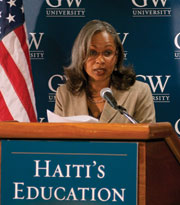 Haitian first lady and GW alumna Elisbeth Delatour Préval, MBA ’88, spoke in March at GW about her country’s devastation and its effects on the country’s already-troubled school system.
Haitian first lady and GW alumna Elisbeth Delatour Préval, MBA ’88, spoke in March at GW about her country’s devastation and its effects on the country’s already-troubled school system.
In the wake of January’s devastating 7.0-magnitude earthquake that leveled the Haitian capital and other parts of the Caribbean nation, the GW community mobilized to lend immediate support while also planning for long-term aid efforts. A variety of GW connections to Haiti made the efforts particularly relevant.
Campus activities during the aftermath were punctuated in March, when Haitian first lady and GW alumna Elisabeth Delatour Préval, MBA ’88, delivered an emotional speech at the Elliott School of International Affairs before a symposium on the future of her country’s inadequate, and now shattered, school system.
“Most of us sometimes are inclined or prefer to believe that we are still in a nightmare; that those horrible images of kids trapped under the concrete or the masses of bodies accumulated along the street will vanish once we wake up,” she said. “But it is a nightmare that lasts.”
In the days and weeks immediately after the earthquake, relief efforts took shape across the university.
GW hosted a daylong ID card campaign, “Swipe Your GWorld for Haiti,” which raised more than $6,300 to be divided between the nonprofit Project Medishare and the American Red Cross. Around campus there were bake sales, donation drives, and other events, including a fundraising party in the Marvin Center ballroom and a candlelight vigil, both organized by a coalition of groups led by the campus’ Caribbean Student Association.
A world away, among the first rescuers on the ground in Haiti were two doctors from GW’s Department of Emergency Medicine, a professor of emergency medicine and engineering, as well as alumnus and current graduate student Scott Schermerhorn, BS ’07, all of whom are members of the Fairfax County, Va., international urban search and rescue team. The group rescued 16 people from the rubble.
Others from the Medical Center also left to tend to Haitian victims, and plans were being made for future trips by faculty members.
Among the vast number of fatalities in Haiti was at least one member of the GW alumni community. Chrystel Cancel had earned her Master in Tourism Administration degree from GW in 2006, and at the time of the quake was in Haiti working on a tourism development project for the U.S. Agency for International Development.
There were, however, also moments of joy: Alumnus Rick Santos, BA ’85, who leads the nonprofit IMA World Health, was rescued after a harrowing 50 hours trapped inside a collapsed building.
Global Forum Probes U.S.-Asia Affairs
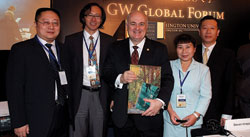
President Steven Knapp with alumni from
Asia during the inaugural Global Forum, held
Nov. 13-14 in Hong Kong.
The George Washington University’s inaugural Global Forum, held in Hong Kong Nov. 13 and 14, brought together nearly 200 faculty members, alumni, friends, and experts from Asia and the United States to discuss international political, business, economic, and security issues.
In his State of the University address at the forum, GW President Steven Knapp said the university is pursuing research relevant to Asia and is committed to contributing to the solution of national and global problems.
“Our aspiration now is to match the power of our teaching with the power of our research,” President Knapp said. “There is no more exciting way to learn than to work with a professor who is pushing the frontier of knowledge, whether the field is neuroscience, literature, environmental engineering, or international law.”
The forum, which was created to promote the exchange of ideas, featured several panel discussions in which distinguished guests and experts examined the United States and Asia during a time of change. The forum’s keynote speakers—Hon. Susan C. Schwab, PhD ’93, American educator and former U.S. trade representative, and Adm. William A. Owens, MS ’76, chairman and CEO of AEA Investors Asia—spoke about U.S.-Asia trade relations and trade politics, and peace and security in Asia, respectively.
Zeb Eckert, BA ’03, a Hong Kong-based reporter for Bloomberg Television, moderated a panel focused on economic and business trends in the Asia-Pacific region, with panelists GW Law professor Donald Clarke; Christopher Fussner, BA ’79, president of TransTechnology; William Ireton, a GW parent and president and representative director of Warner Entertainment Japan; and Susan Phillips, dean of GW’s School of Business.
In another panel, director of GW’s School of Media and Public Affairs Frank Sesno moderated a discussion on topics prevalent in the
news on U.S. foreign policy in Asia. Amb. Ralph
“Skip” Boyce, BA ’74; David Shambaugh,
BA ’78, director of GW’s China Policy Program; and James T.H. Tang, professor of politics and public administration, Hong Kong University, participated in the discussion.
For the forum’s final panel, Zoher Abdoolcarim, Asia editor of Time magazine, moderated a discussion on international security issues. Panelists were Michael Brown, dean of GW’s Elliott School of International Affairs and professor of international affairs and political science; Koji Murata, MPhil ’95, professor of
international security studies, Doshisha University
in Japan; Chu Shulong, PhD ’93, professor of political science and international relations and deputy director of the Institute of International Strategic and Development Studies at the Tsinghua University’s School of Public Policy and Management (Beijing); Amb. Yim Sung-Joon, president of the Korea Foundation; and Phongthep Thepkanjana, MCL ’79, MCL ’83.
More than 1,000 students from Asia currently attend GW, and more than 3,000 alumni are concentrated in Asia—almost
50 percent of GW’s international alumni.
“The world is watching, and for GW to stake an interest in Asia at this time is critically important,” Mr. Eckert said.
The inaugural GW Global Forum was sponsored by FedEx. Official media partners were Time and Bloomberg, and supporting organizations included the American Chamber of Commerce in Hong Kong and the Asia Society.
Athlete Earns
All-American Status
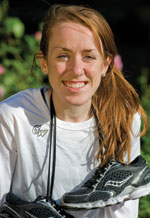
Cross Country senior Megan Hogan is the first GW women’s runner to achieve All-American status and the first Colonial to win the Atlantic 10 championships.
Jessica McConnell
Eight hundred meters into the championship race in Terre Haute, Ind., on Nov. 23, senior Megan Hogan was tripped and passed by 45 runners. But Ms. Hogan, the Atlantic 10 Conference Women’s Cross Country Student-Athlete of the Year, wasn’t out for the count. After 3.7 miles, Ms. Hogan crossed the finish line 27th overall, beating out 228 of the nation’s top female runners to earn All-American status—and slashed her last year’s time by 36 seconds at 20:34.
The finish was a “happy” one for Ms. Hogan, the first GW women’s runner to achieve All-American status and the first Colonial to win the Atlantic 10 championships.
“I felt really strong running at nationals,” Ms. Hogan says. “I got a little bit scared when someone tripped me. I lost position, and my entire left arm went numb. But I came back and I am really happy with my performance.”
A former high school and college basketball star, Ms. Hogan only started running cross country two years ago at the suggestion of a friend. She won her first three races handily, quit basketball, and transferred to GW.
“Cross country is the perfect balance between a team sport and an individual sport,” says Ms. Hogan, a native of Saratoga Springs, N.Y. “You are out there all alone in a race, but your team is still there with you. I love racing and the toughness of cross country. There is no collegiate sport like it.”
Cross country races are run on open courses—golf courses or large fields—frequently over rough terrain that includes hills, streams, and other obstacles. There can be as many as 400 competitors in a cross country race. At the college level, distances for female runners are typically five and six kilometers (about 3.1 and 3.7 miles). Ms. Hogan holds GW records in both distances; her best cross country time in the six kilometers is 20:05—an astounding 5:20 per mile.
“Training is tough,” says Ms. Hogan, who estimates she runs 70 miles a week.
She says the hardest part about running cross country is knowing when to stop. “I hate backing off, because I feel like I am losing fitness, but in reality if my body feels like it needs to rest, I am only going to make it worse if I don’t. It’s something a lot of runners struggle with.”
Ms. Hogan, who also runs track in the winter and spring, is majoring in interior design with a minor in art history. She is considering pursuing an MBA at GW next year, which would enable her to exercise her additional year of eligibility and run a third season of cross country at the University.
“Mostly, I think remembering that running should be fun is important,” Ms. Hogan says. “If you are not having fun, then there is no point.”
—Rachel Muir
Grants Spur Global
Security Research
GW’s Elliott School of International Affairs is leading three major research programs focused on global security, thanks to nearly $2 million in grant funding from Carnegie Corporation of New York and the John D. and Catherine T. MacArthur Foundation.
The programs—the Rising Powers Initiative, the Project on Middle East Political Science, and the Program on New Approaches to Regional Security (PONARS) Eurasia—aim to enhance scholarship, raise public policy awareness, and inform international policymaking on global security issues.
The Rising Powers Initiative will examine
the internal foreign policy dynamics and identity issues of China, India, Russia, Iran, Japan, South Korea, and the Association of Southeast Asian Nations—actors that will significantly influence U.S. global engagement and international politics in coming years. A series of regional seminars and roundtables, coursework, Washington briefings, Web site development, and a published book volume will examine domestic debates within these countries regarding their place in Asian and world affairs. This initiative, led by GW international affairs faculty members Deepa Ollapally, Henry R. Nau, and Mike Mochizuki, is housed in the Elliott School’s Sigur Center for Asian Studies and is supported by a $349,900 grant from the Carnegie Corporation and a $300,000 grant from the MacArthur Foundation.
With a $475,000 grant from the Carnegie Corporation, Marc Lynch, director of GW’s Institute for Middle East Studies, will lead the Project on Middle East Political Science (POMEPS), an effort aimed at building political science expertise in the United States about the Middle East. The initiative will develop Middle East specialists, who are underrepresented currently in political science and international relations despite the significance of the region in global politics, economics, and national security. The POMEPS initiative will create a network of scholars; provide outreach, training, and opportunities for younger scholars to engage with peers, mentors, policymakers, and journalists; integrate regional expertise into public and policy debates; and prepare junior faculty for hiring and tenure at leading universities. The initiative will include the development of an outlet for online publication at Foreign Policy magazine’s new Middle East Channel.
In addition, The George Washington University will now lead the Program on New Approaches to Regional Security (PONARS) Eurasia. Founded in 1997 as a multinational network of scholars, PONARS Eurasia seeks to catalyze and sustain collaboration between U.S. and Eurasian scholars on issues vital to global security, such as nuclear proliferation, ethnic conflict, terrorism, energy security, economic reform, climate change, state-building and a host of others. PONARS Eurasia is supported by a $751,500 grant from Carnegie Corporation.
Library 2.0
New digitization technology promises to revolutionize preservation and dissemination of rare books.
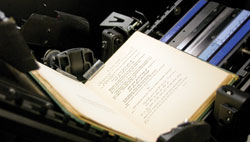
William Atkins
The KABIS III automatic book digitizer looks like it could launch something back to the future if it hit 88 mph on the speedometer. But however unusual the unit appears, Gelman Library’s new digitizer can impact the future of libraries, particularly for rare books or those in poor physical condition.
During a demonstration, representatives of Kirtas Technologies, which is partnering with GW and Georgetown University on a project called Cultural Imaginings, placed a late-19th-century copy of a translation of the Persian poetry collection Rubaiyat of Omar Khayyam on the KABIS III. The machine used a suction robotic arm to gently turn the pages, which it photographed automatically at a rate of 3,000 pages an hour in 400-dots-per-inch resolution.
Even a cursory look at the freshly printed copies of the Rubaiyat that came from the KABIS III showed the machine’s remarkable attention to detail. But the most important aspect might not appear on the finished product at all, according to Lotfi Belkhir, CEO of Kirtas.
The KABIS III captures all sorts of metadata that make the books searchable and accessible for repackaging for a variety of devices from Kindles to mobile devices. The KABIS III can also operate remotely, so someone could request a copy of a book in Gelman’s collection from another country, and Kirtas staff could use the metadata from the Foggy Bottom-based scan to transmit the file. The requesting party could have a printed book in hand without having to expend the financial and time investment of traveling to GW.
According to Martha Whittaker, head of technical services at Gelman, the project, which is partially funded by a grant from the Institute of Museum and Library Services, has tremendous technological implications.
“I am often asked, ‘Isn’t Google already digitizing everything?’ ” she says. “In fact, we are not just digitizing and scanning, we are also doing OCR [optical character recognition] and producing very high-quality printing. You will never find a handprint in the middle of a KABIS III scan like you do with Google. This is true museum- and library-quality scanning.”
According to Ms. Whittaker, GW is the first university in the country to own a KABIS III. GW also purchased a Kirtas SkyView Flatbed Imaging System, which digitizes maps, large-format books, and artifacts that are too large or fragile to fit in the KABIS III.
The equipment has potential uses beyond the Cultural Imaginings project. GW is considering a nonexclusive contract to be part of Kirtasbooks.com, an online bookshop, which allows customers to request books to be printed on demand, Ms. Whittaker says. The books, like the copies of the Rubaiyat, retail for $10 apiece, and GW would get a royalty on any sales of books from its collection. Of course, GW still has to comply with U.S. copyright laws, but most books published before 1923 are in the public domain.
As part of the Cultural Imaginings Project, GW is digitizing more than 2,500 monographic volumes and manuscripts from its collection of Middle East and North African books. In addition, a big part of the project is GW’s opportunity to assess the scanner from a cost perspective.
“The IMLS gives these grants for institutions to be leaders in evaluating the technology and the cost to see if this is the best technology to use,” says Ms. Whittaker.
GW is “very pleased with the results so far,” she adds, and as part of the two-year grant that started Oct. 1, 2009, GW’s and Georgetown’s report to the IMLS will be made public.
— Menachem Wecker
George Welcomes…
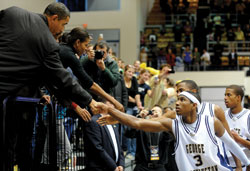
President Barack Obama and the first family attended the GW men’s basketball game against visiting Oregon State on Nov. 28 at the Charles E. Smith Center. Oregon State coach Craig Robinson is the brother of first lady Michelle Obama. Along with the president, first lady Michelle Obama, daughters Malia and Sasha, and Marian Robinson, the mother of coach Robinson and the president’s mother-in-law, attended the game. Despite a furious last-minute rally, the Colonials fell short with a final score of 64-57. GW President Steven Knapp presented President Obama with a GW basketball game jersey, shorts, and a signed basketball from the Colonials.
Mitchell Layton
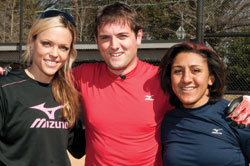
Before Elana Meyers, BA ’06 (right), earned a bronze medal for women’s bobsled in the 2010 Olympics in Vancouver, she was a star on the George Washington women’s softball team. In a March 9
homecoming, she returned to GW’s Mount Vernon Campus for a special segment with MSNBC correspondent Luke Russert, where she swung at 10 pitches from Olympic softball pitcher Jennie Finch, a two-time medalist, to win $1,000 for charity.
William Atkins
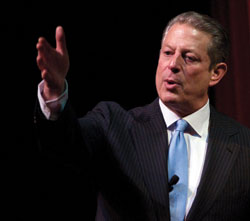
In a Nov. 5 speech at GW’s Lisner Auditorium, former Vice President Al Gore discussed a range of potential environmental solutions as outlined in his new book Our Choice: A Plan to Solve the Climate Crisis. The speech and book signing were sponsored in partnership with the D.C. bookstore Politics and Prose.
Jessica McConnell
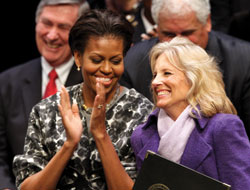
First lady Michelle Obama and Jill Biden, wife of Vice President Joe Biden, spoke at Lisner Auditorium on Veterans Day during the launch of Mission Serve: Forging a Continuum of Service, an initiative to integrate military and civilian service through partnership with more than 50 organizations.
William Atkins
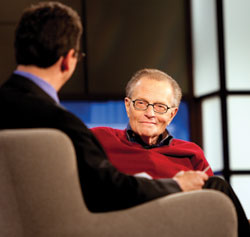
School of Media and Public Affairs Director Frank Sesno interviewed Larry King as part of the school’s Public Affairs Project Conversation Series in March. King discussed his career, the ever-changing media landscape, and the influence of 24-hour cable news. Keep an eye out for Mr. King’s new GW buff-and-blue suspenders, which he has worn at least once during his CNN show since his visit to campus.
William Atkins
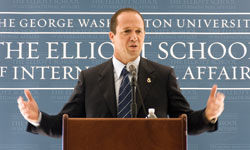
Nir Barkat, mayor of Jerusalem, discussed his vision for his city Nov. 6 during an event at the Elliott School of International Affairs. The talk was part of the Exxon Mobil-sponsored Middle East Policy Forum, which brings leaders to campus to discuss current and emerging issues of the region.
Jessica McConnell
|
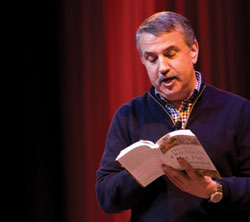
New York Times columnist Thomas Friedman read from his book Hot, Flat and Crowded: Why We Need a Green Revolution—and How It Can Renew America during a Jan. 21 lecture in Lisner Auditorium. GW’s freshman class read the book last summer as part of the university’s Freshman Reading Program.
Jessica McConnell
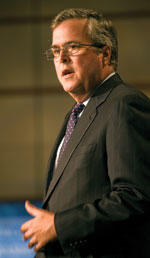
Former Florida Gov. Jeb Bush outlined his vision for the Republican Party during an Oct. 21 event at the Jack Morton Auditorium.
William Atkins
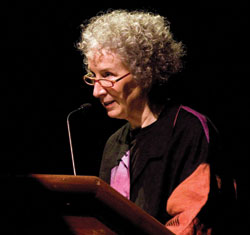
Author Margaret Atwood performed a dramatic reading of her new novel The Year of the Flood Oct. 30 at Lisner Auditorium. GW students helped the narrative come to life by acting out scenes and singing in a gospel-inspired choir.
Jessica McConnell
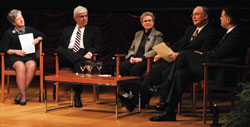
On March 2, the GW Luther Rice Society hosted the second annual Wall Street Symposium, featuring
a panel of leading alumni in the financial services industry—including Diana B. Henriques, BA ’69, senior financial writer, The New York Times; Ira “Ike” Sorkin, JD ’68, SEC enforcement expert and white-collar defense attorney, who represented Bernard L. Madoff; Abby Joseph Cohen, MA ’76, senior U.S. investment strategist, Goldman Sachs; James Runde, MS ’73, special adviser and former vice chairman, Morgan Stanley; and Darryl Steinberg, JD ’89, managing director and senior tax counsel, Lehman Brothers—to share their experiences during the financial crisis.
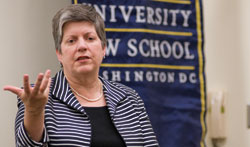
Secretary of the U.S. Department of Homeland Security Janet Napolitano said at a GW Law School event Oct. 21 that all Americans must assume a shared sense of responsibility for keeping the country safe. The talk was sponsored by the GW National Security Law LLM Program and Dickstein Shapiro law firm.
Jessica McConnell
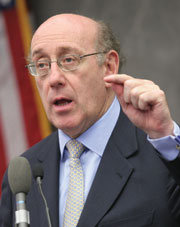
Kenneth Feinberg, the special master for executive compensation for the Troubled Asset Relief Program at the U.S. Treasury Department, spoke at GW Law School Oct. 23, one day after his decision to sharply curtail executive pay at top banks and automakers became public.
|





















